Lembeh, Indonesia, is part of the famous Coral Triangle, the most biodiverse coral-reef region in the world. Thousands of divers, from photographers to biologists, to the merely curious visit this region every year — not for coral reefs, but for the diversity of critters hiding it its dark sand. After listening to many of my peers rave about muck diving, as it’s called, and the weird and wonderful aquatic life that awaits, I decided to spend a week in Lembeh. Not only was I converted, but I am now hooked on muck diving and, with the help of expert photographers Simon Buxton (also owner) and Sonja Geier at NAD-Lembeh Resort, we’ve compiled a list of must-do dives in Lembeh, critter capital of the dive world.
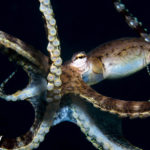
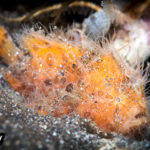
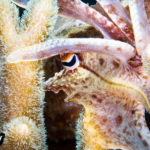
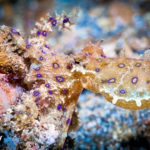
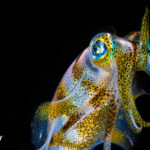
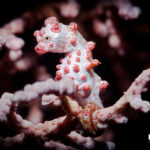
Goby A Crab
Here you’ll find both mototi and blue-ringed octopus, as they prefer bottom compositions with more rubble and rocks. Look also for gobies, frogfish, nudibranchs, the beautiful mandarinfish and the Holy Grail of Lembeh — rhinopias. The wall starts at 10 feet (3 m) and drops to 80 feet (20 m), with sand/rubble at 90 feet (27 m). Coral formations in the shallows are worth poking around at this site, a 15-minute boat ride from the resort.
Nudi Falls
As the name suggests, there are a plethora of nudibranchs at this site, as well as wunderpus and blue-ringed octopus and flamboyant cuttlefish. There are corals and a mini-wall starts at 3 feet (1 m), dropping to 80 feet (20 m) on the sand/rubble with coral patches at 93 feet (28 m). Only a 5-minute boat ride opposite the resort, it’s best to visit this site on a low tide with no current, as strong currents make it inaccessible on a high tide.
Coral Garden and Nudi Retreat
Both these sites are famous for macro life, so bring a magnifying glass or your macro lens. You’ll spot lots of nudibranchs, electric clams and tiny pygmy seahorses — or at least your guide will, and then point them out to you. The wall starts at 3 feet (1 m) and drops to 100 feet (30 m), with soft/hard corals and big boulders scattered throughout. There are strong currents on high tide, so you can only dive here on slack tide. These sites are a 10-minute boat ride north of the resort.
Jahir 1 and Aer Perang 1,2 and 3
These sites slope down from the shore starting at around 3 to 6 feet (1 to 2 m) on an all muck/sandy bottom. It’s best to dive them at low tide and you can expect a giant variety of animals, including seahorses, hairy frogfish, coconut octopus, longarm octopus, Costasiella and Thecacera nudibranchs. One of Lembeh’s best night dives is at Aer Perang, a shallow site that’s perfect after a full day of diving. It’s known as an octopus heaven and is also the area’s best spot to see bobbit worms.
Hairball
This is one of Lembeh’s most famous sites which, on a good day, is amazing for the quantity and diversity of critters on hand. On certain days, however, it can be desolate. “It’s always better to listen to your guides as they know better which sites to visit, rather than going on historical information from previous guests and demanding the sites when you visit,” says NAD-Lembeh resort manager Sonja Geier, noting that most guests want to visit Hairball.
“There are a lot of variables at play when determining which dive sites to visit — current, season, critter cycles, etc. For example, the Aer Bajos sites are not at their best between Dec and June due to wind from the north. In periods of high wind, it might be terrible visibility.”
More challenging sites
Some of the more-challenging dive sites are located further north of Lembeh Strait. These are deeper and more exposed to current and surge, so as well as making for challenging dive conditions, they’re also a bit harder for photography. The payoff can be larger tuna and mackerel as well as plentiful macro life. These sites include Batu Kapal, Angel’s Window and California Dreaming.
Acknowledgements Simon Buxton and Sonja Geier of www.nad-lembeh.com for expert advice.
The post Top Dive Sites in Lembeh: Critter Capital of the Dive World appeared first on Scuba Diver Life.
from Scuba Diver Life https://ift.tt/2w2r6g6
No comments:
Post a Comment